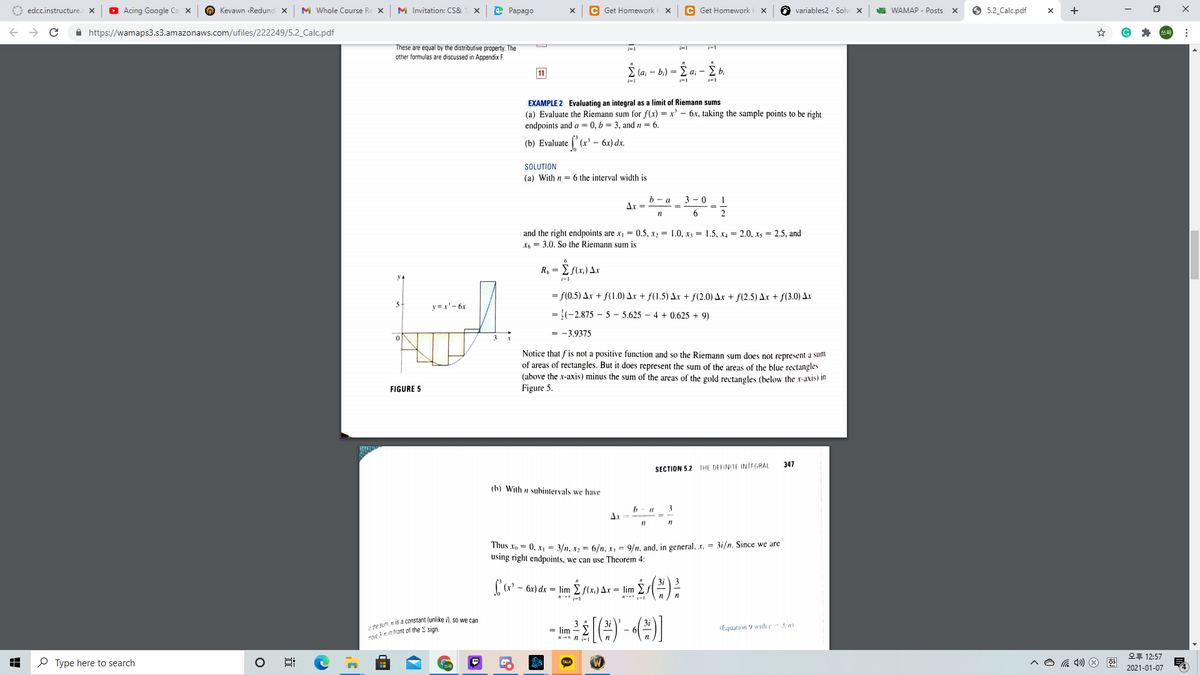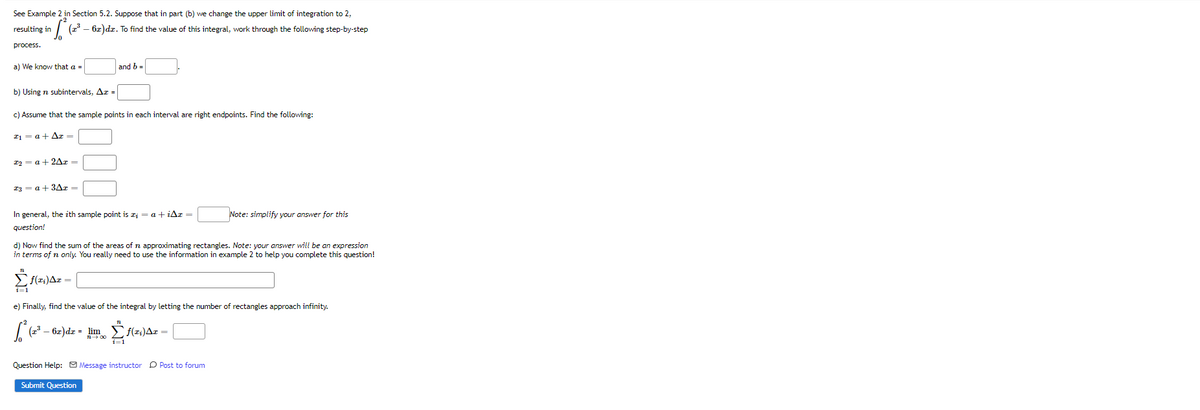O edcc.instructure X O Acing Google Co x O Kevawn Redund x M Whole Course Re x M Invitation: CS& x e Papago C Get Homework X C Get Homework X O variables2 - Solv x WAMAP - Posts X O 52 Calc.paf i https://wamaps3.s3.amazonaws.com/ufiles/222249/5.2 Calc.pdf These are equal by the datrbutve property The other formulas are discussed in Acpends 11 È la, - b.) = E a, – É b, EXAMPLE 2 Evaluating an integral as a limit of Riemann sums (a) Evaluate the Riemann sum for f(x) -x' - 6x, taking the sample points to be right endpoints and a - 0, b-3, and a -6. (b) Evaluate '(r' - 6x) dx. SOLUTION (a) With a-6 the interval width is -a3-0 Ar= Ar- 6 and the right endpoints are x, - 0.5. x: = 1.0, x = 1.5, x. - 2.0. xs = 25, and X - 3.0. So the Riemann sum is R, - E fLr,) Ar - S(0.5) Ar + S(1.0) ar + f(1.5) Ar + f(2.0) Ar + f(2.5) Ar + f(3.0) Ax y'-f -(-2.875 - 5 - 5.625 - 4 + 0.625 + 9) - -3.9375 Notice that f is not a positive function and so the Riemann sum does not represent a sum of areas of rectangles. But it does represent the sum of the areas of the blue rectangles (above the x-axis) minus the sum of the areas of the gold rectangles (below the x-aisi in Figure 5. FIGURE S 347 SECTION S2 HE DEFINITE INIEGRAL th) With a suhintervals we have Thus X0, x - yn, x;- 6/n, , 9/n, and, in general, x,- 3i/n. Since we are using right endpoints, we can use Theorem 4: C - 6z) dr = lim E fix.) Ar - lim a Constant unike il so we can ientont of the sign - lim - P Type here to search O Ei A O A 40 ® 한 2 12:57 局 2021-01-07
O edcc.instructure X O Acing Google Co x O Kevawn Redund x M Whole Course Re x M Invitation: CS& x e Papago C Get Homework X C Get Homework X O variables2 - Solv x WAMAP - Posts X O 52 Calc.paf i https://wamaps3.s3.amazonaws.com/ufiles/222249/5.2 Calc.pdf These are equal by the datrbutve property The other formulas are discussed in Acpends 11 È la, - b.) = E a, – É b, EXAMPLE 2 Evaluating an integral as a limit of Riemann sums (a) Evaluate the Riemann sum for f(x) -x' - 6x, taking the sample points to be right endpoints and a - 0, b-3, and a -6. (b) Evaluate '(r' - 6x) dx. SOLUTION (a) With a-6 the interval width is -a3-0 Ar= Ar- 6 and the right endpoints are x, - 0.5. x: = 1.0, x = 1.5, x. - 2.0. xs = 25, and X - 3.0. So the Riemann sum is R, - E fLr,) Ar - S(0.5) Ar + S(1.0) ar + f(1.5) Ar + f(2.0) Ar + f(2.5) Ar + f(3.0) Ax y'-f -(-2.875 - 5 - 5.625 - 4 + 0.625 + 9) - -3.9375 Notice that f is not a positive function and so the Riemann sum does not represent a sum of areas of rectangles. But it does represent the sum of the areas of the blue rectangles (above the x-axis) minus the sum of the areas of the gold rectangles (below the x-aisi in Figure 5. FIGURE S 347 SECTION S2 HE DEFINITE INIEGRAL th) With a suhintervals we have Thus X0, x - yn, x;- 6/n, , 9/n, and, in general, x,- 3i/n. Since we are using right endpoints, we can use Theorem 4: C - 6z) dr = lim E fix.) Ar - lim a Constant unike il so we can ientont of the sign - lim - P Type here to search O Ei A O A 40 ® 한 2 12:57 局 2021-01-07
Linear Algebra: A Modern Introduction
4th Edition
ISBN:9781285463247
Author:David Poole
Publisher:David Poole
Chapter6: Vector Spaces
Section6.6: The Matrix Of A Linear Transformation
Problem 30EQ
Related questions
Concept explainers
Transformation of Graphs
The word ‘transformation’ means modification. Transformation of the graph of a function is a process by which we modify or change the original graph and make a new graph.
Exponential Functions
The exponential function is a type of mathematical function which is used in real-world contexts. It helps to find out the exponential decay model or exponential growth model, in mathematical models. In this topic, we will understand descriptive rules, concepts, structures, graphs, interpreter series, work formulas, and examples of functions involving exponents.
Question

Transcribed Image Text:O edcc.instructure. X
O Acing Google Co x
O Kevawn «Redund x
M Whole Course Re X
M Invitation: CS&
e Papago
C Get Homework E X
Get Homework
A variables2 - Solve X
A WAMAP - Posts x
5.2 Calc.pdf
+
A https://wamaps3.s3.amazonaws.com/ufiles/222249/5.2_Calc.pdf
These are equal by the distributive property. The
-1
other formulas are discussed in Appendix F.
11
(а, — b) —
E b.
a, -
EXAMPLE 2 Evaluating an integral as a limit of Riemann sums
(a) Evaluate the Riemann sum for f(x) = x' – 6.x, taking the sample points to be right
endpoints and a = 0, b = 3, and n = 6.
(b) Evaluate (:
x' - 6x) dx.
SOLUTION
(a) With n = 6 the interval width is
b - a
3 - 0
Ar =
%3D
6
2
and the right endpoints are x, = 0.5, r2 = 1.0, x; = 1.5, x, = 2.0, xs = 2.5, and
X, = 3.0. So the Riemann sum is
R, =
i-
= f(0.5) Ar + f(1.0) Ar + f(1.5) Ar + f(2.0) Ax + f(2.5) Ax + f(3.0) Ax
5
y =x'- 6x
= }(-2,875 – 5 – 5.625 – 4 + 0.625 + 9)
= -3.9375
Notice that f is not a positive function and so the Riemann sum does not represent a sum
of areas of rectangles. But it does represent the sum of the areas of the blue rectangles
(above the x-axis) minus the sum of the areas of the gold rectangles (below the x-axis) in
FIGURE 5
Figure 5.
347
SECTION 5.2 THE DEFINITE INTEGRAL
(b) With n subintervals we have
b - a
3
Thus Xp = 0, x, = 3/n, x, = 6/n, X= 9/n, and, in general, x, = 3i/n. Since we are
using right endpoints, we can use Theorem 4:
3i 3
[(r' - 6x) dx = lim E S(x,) Ax = lim
te sum, N is a constant (unlike
nve 3n in front of the E sign
so we can
= lim
Equation 9 withe
오후 12:57
P Type here to search
^O G ) O
2021-01-07

Transcribed Image Text:See Example 2 in Section 5.2. Suppose that in part (b) we change the upper limit of integration to 2,
resulting in
| (2 – 6z)dr. To find the value of this integral, work through the following step-by-step
process.
a) We know that a =
and b =
b) Using n subintervals, Ar =
c) Assume that the sample points in each interval are right endpoints. Find the following:
21 = a + Az =
22 = a + 2Az =
23 = a + 3Az =
In general, the ith sample point is r; = a + iAr =
Note: simplify your answer for this
question!
d) Now find the sum of the areas of n approximating rectangles. Note: your answer will be an expression
in terms of n only. You really need to use the information in example 2 to help you complete this question!
f(r:)Az =
i=1
e) Finally, find the value of the integral by letting the number of rectangles approach infinity.
[ (2" – 6z)dz = lim E f(#:)Az =
1=1
Question Help: O Message instructor D Post to forum
Submit Question
Expert Solution
This question has been solved!
Explore an expertly crafted, step-by-step solution for a thorough understanding of key concepts.
This is a popular solution!
Trending now
This is a popular solution!
Step by step
Solved in 4 steps

Knowledge Booster
Learn more about
Need a deep-dive on the concept behind this application? Look no further. Learn more about this topic, calculus and related others by exploring similar questions and additional content below.Recommended textbooks for you

Linear Algebra: A Modern Introduction
Algebra
ISBN:
9781285463247
Author:
David Poole
Publisher:
Cengage Learning


Linear Algebra: A Modern Introduction
Algebra
ISBN:
9781285463247
Author:
David Poole
Publisher:
Cengage Learning
